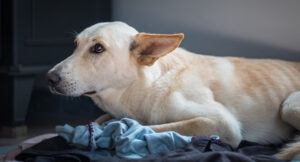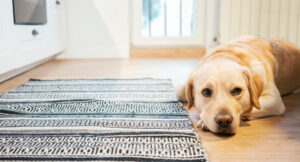How to manage separation anxiety in dogs

40% of dog owners report pets experiencing some form of separation anxiety, with half of pet owners claiming to have made changes to their working week to suit their pets’ needs according to a census by PetPlan.
As a pet owner, you want to be there for your animals and prevent any suffering, but when your dog has separation anxiety, this can feel like an impossible task.
Here’s our advice on how to manage and prevent separation anxiety in your dog.
What is separation anxiety?
Separation anxiety in dogs, also known as separation-related behaviour (SRB), is frustration and distress caused by being left alone.
Dogs are very social animals; this is why they thrive being part of a family and why they are so popular as pets. This is also why they can become very anxious when they’re left home alone and are separated from the family ‘pack’.
Separation anxiety is a real, overwhelming sensation that affects some dogs and can impact their quality of life.
How to recognise signs of separation anxiety in dogs
If you think your dog may be experiencing separation anxiety, here are some signs to look out for:
- Whining, barking or howling
- Pacing or following you around as you get ready to leave
- Trembling or shaking
- Tucking their tail
- Coming home to toilet accidents when they are normally toilet trained
- Destruction of furniture, carpets or items while you were out
- Excessive excitement when you come home
In short, if they display any unusual behaviours as you’re getting ready to leave the house or act destructively while you’re away, it’s likely that your dog is experiencing separation anxiety.
Why does separation anxiety develop?
No dog is born with separation anxiety, it’s a learned behaviour. It mainly occurs when a pet has never learned that it’s ok to be alone.
Separation anxiety can also develop following big changes in a dog’s life such as moving house, changing ownership or a traumatic event.
In the wake of Covid-19 pandemic when we all suddenly spent a lot more time in our homes than normal, dogs who had previously been quite content to be left alone have now developed separation anxiety and puppies born during this time never learned what it was like to spend time alone.
Our kennel team has reported a significant increase in dogs coming to us with pre-existing behavioural issues such as separation anxiety in the last few years. We aim to provide enough support and information to prevent the surrender of any animal due to avoidable issues or behavioural challenges which can be managed.
The best way to treat separation anxiety is to stop it developing in the first place, but there are also ways to manage and improve a dog’s mental state if they do get anxious.

Tips for preventing separation anxiety
When bringing a new pet into the family, it’s important to strike the balance between giving them enough love and attention to settle in and teaching them that being alone at times is a positive and comfortable thing.
It isn’t appropriate to bring a puppy home and leave them home alone for hours on end, but neither is it appropriate to give them your total undivided attention at all hours of the day.
Here are some tips for preventing separation anxiety in your new pet:
1. Create a safe space for them in your home.
Make sure your home feels like a comfortable, safe space for them. As you get to know your pet, be aware of their individual preferences. For example, do they choose to lie close to people or in a quiet corner away from noise and activity?
This can help advise the space you set up for them when leaving them home alone, some dogs might feel very comfortable in a crate if they view it as their own private den, while others might feel safer in a wider space with some music left on for company.
Once you have created a safe space for them to stay in alone, make sure this space is familiar to them.
If, for example, your dog is going to be left in the kitchen, the more time they can spend in the kitchen with you, building up positive experiences and enjoying that environment, then the happier they will be spending time there alone. Allow them time to get to know the smells and noises of that space so that they’re not suddenly overwhelmed by them when left there alone.
2. Start by leaving them alone for short periods and gradually build up to longer periods
Once you know that your dog is comfortable in their safe space, start slowly by briefly walking away and returning while they are relaxing there.
You can try offering them a tasty chew in their bed, then getting up from your chair and walking into another room. Spend 20 seconds or so faffing around, then calmly return without making a fuss. You can absolutely offer a comforting pat on the head if they look for it but try to act like this is completely normal and you’ve done nothing worth mentioning.
The next step is to build the length of time you leave them for very gradually. It’s important to proceed at your dog’s page and be prepared for the odd setback along the way, this is completely normal. The worst thing you can do is rush this stage and suddenly leave them for hours at a time when they have only just become comfortable with being left for a few minutes.
3. Understand the signs that your dog is comfortable, as well as those that indicate stress
Some people like to monitor the behaviour of their dogs while they’re out through the use of cameras which you can connect to your phone. But even without this technology, how your dog acts before you leave and when you get back is a good indication of how they feel.
Look out for signs of stress while you’re getting ready to leave or when you return.

How to manage separation anxiety in dogs
If your dog is already displaying signs of separation anxiety, or if you have an older dog who suddenly starts to develop separation anxiety, try going back to square one and gradually building up the time they are left alone as you would for a new puppy.
When they display signs of distress, offer them comfort but remain calm and show them that there is nothing to worry about. We know that you’re excited to see your dog when you get home too but rushing to them and making a big fuss about them as soon as you step through the door can exacerbate the anxiety they feel when you’re not there.
If you come home to find a big mess after being out, avoid scolding your dog as they won’t understand what they have done wrong. These destructive behaviours are simply a form of distraction from the emotional distress they are experiencing, like how humans bite our nails, doodle or comfort eat when we are stressed or unhappy.
Suddenly getting angry at the very moment they’re celebrating your return only adds an element of fear for our pets. It teaches them that we are no longer as trustworthy as we once were, and now instead of just feeling anxious when separated, there is another reason to feel afraid too.
You can also prevent separation anxiety by consistently providing your pet with enough mental and physical stimulation. A dog who has had no opportunity to use their energy is far more likely to get into mischief than one who’s ready for a snooze. Take them for plenty of good walks and offer them items like chews, toys, or puzzle games to get their brains going.
Separation anxiety and rehoming
For the pets who come into our care, especially those already showing some signs of separation anxieties, it can be an incredibly overwhelming experience. Not only are they somewhere new, but they are completely separated from their owners who they love and trust.
Our team work tirelessly to ensure these pets are loved and cared for, walked, played with, fed their favourite meals and have a cosy bed to lay their heads, but it can take them time to adapt.
Often pets like these can take longer to settle in and can struggle when they are rehomed to a new place again. In these cases, we have to go back to the very basics of building trust and security to help them feel comfortable enough to be left alone.
To support our work and help us provide the care and attention our animals deserve, please leave a gift today.